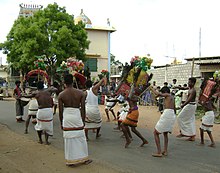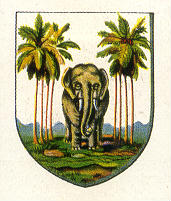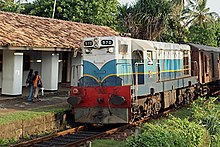MORE
According to colonial British reports, this is a natural causeway which was formerly complete, but was breached by a violent storm in 1480.[21] The island consists mostly of flat-to-rolling coastal plains, with mountains rising only in the south-central part. Amongst these is the highest point Pidurutalagala, reaching 2,524 metres (8,281 ft) above sea level.
The climate of Sri Lanka can be described as tropical and warm. Its position between 5 and 10 north latitude endows the country with a warm climate moderated by ocean winds and considerable moisture. The mean temperature ranges from about 16 °C (61 °F) in the Central Highlands, where frost may occur for several days in the winter, to a maximum of approximately 33 °C (91 °F) in other low-altitude areas. The average yearly temperature ranges from 28 °C (82 °F) to nearly 31 °C (88 °F). Day and night temperatures may vary by 4 °C (7 °F) to 7 °C (13 °F). During the coldest days of January, many people wear coats and sweaters in the highlands and elsewhere.
May, the hottest period, precedes the summer monsoon rains. The rainfall pattern is influenced by monsoon winds from the Indian Ocean and Bay of Bengal: as the winds encounter the mountain slopes of the Central Highlands, they unload heavy rains on the slopes and the southwestern areas of the island. Some of the windward slopes receive up to 2,500 millimetres (98 in) of rain each month, but the leeward slopes in the east and northeast receive little rain. Periodic squalls occur and sometimes tropical cyclones bring overcast skies and rains to the southwest, northeast, and eastern parts of the island.
Between December to March, monsoon winds come from the northeast, bringing moisture from the Bay of Bengal. Humidity is typically higher in the southwest and mountainous areas and depends on the seasonal patterns of rainfall, and places like Colombo experience daytime humidity above 70% all year round, rising to almost 90% during the monsoon season in June. Anuradhapura experiences a daytime low of 60% during the monsoon month of March, but a high of 79% during the November and December rains. In the highlands, Kandy's daytime humidity usually ranges between 70% and 79%.
EARLY PERIODS

Paleolithic human settlements have been discovered at excavations in several cave sites in the Western Plains region and the South-western face of the Central Hills region. Anthropologists believe that some discovered burial rites and certain decorative artifacts exhibit similarities between the first inhabitants of the island and the early inhabitants of Southern India. Recent bioanthropological studies have however dismissed these links, and have placed the origin of the people to the northern parts of India[citation needed]. One of the first written references to the island is found in the Indian epic Ramayana, which described the emperor Ravana as monarch of the powerful kingdom of Lanka, which was created by the divine sculptor Vishwakarma for Kubera, the treasurer of the Gods.[27] English historian James Emerson Tennent also theorized Galle, a southern city in Sri Lanka, was the ancient seaport of Tarshish from which King Solomon is said to have drawn ivory, peacocks and other valuables. The main written accounts of the country's history are the Buddhist chronicles of Mahavansa and Dipavamsa. Sri Lankan coin, 1st century CE. The earliest-known inhabitants of the island now known as Sri Lanka were probably the ancestors of the Wanniyala-Aetto people, also known as Veddahs and numbering roughly 3,000. Linguistic analysis has found a correlation of the Sinhalese language with the languages of the Sindh and Gujarat, although most historians believe that the Sinhala community emerged well after the assimilation of various ethnic groups. From the ancient period date some remarkable archaeological sites including the ruins of Sigiriya, the so-called "Fortress in the Sky", and huge public works. Among the latter are large "tanks" or reservoirs, important for conserving water in a climate that alternates rainy seasons with dry times, and elaborate aqueducts, some with a slope as finely calibrated as one inch to the mile. Ancient Sri Lanka was also the first in the world to have established a dedicated hospital in Mihintale in the 4th century BCE. Ancient Sri Lanka was also the world's leading exporter of cinnamon, which was exported to Egypt as early as 1400 BCE. Sri Lanka was also the first Asian nation to have a female ruler in Queen Anula (47–42 BC).
ANCIENT SRI LANKA

Since ancient times Sri Lanka was ruled by monarchs, most notably of the Sinha royal dynasty that lasted over 2000 years. The island was also infrequently invaded by South Indian kingdoms and parts of the island were ruled intermittently by the Chola dynasty, the Pandya dynasty, the Chera dynasty and the Pallava dynasty. The island was also invaded by the kingdoms of Kalinga (modern Orissa) and those from the Malay Peninsula. Buddhism arrived from India in the 3rd century BCE, brought by Bhikkhu Mahinda, who is believed to have been the son of Mauryan emperor Ashoka. Mahinda's mission won over the Sinhalese monarch Devanampiyatissa of Mihintale, who embraced the faith and propagated it throughout the Sinhalese population. The Buddhist kingdoms of Sri Lanka would maintain a large number of Buddhist schools and monasteries, and support the propagation of Buddhism into Southeast Asia.
20th Century and the World Wars
European colonists established a series of tea, cinnamon, rubber, sugar, coffee and indigo plantations. The British also brought a large number of indentured workersfrom Tamil Nadu to work in the plantation economy. The city of Colombo was established as the administrative centre, and the British established modern schools, colleges, roads and churches that brought Western-style education and culture to the native people.
Increasing grievances over the denial of civil rights, mistreatment and abuse of natives by colonial authorities gave rise to a struggle for independence in the 1930s, when the Youth Leagues opposed the "Ministers' Memorandum," which asked the colonial authority to increase the powers of the board of ministers without granting popular representation or civil freedoms. Buddhist scholars and the Teetotalist Movement also played a vital role in this time.
During World War II, the island served as an important Allied military base. A large segment of the British and American fleet were deployed on the island, as were tens of thousands of soldiers committed to the war against Japan in Southeast Asia.
INDEPENDANCE

Following the war, popular pressure for independence intensified. The office of Prime Minister of Ceylon was created in advance of independence on 14 October 1947, Don Stephen Senanayake being the first prime minister. On February 4, 1948 the country won its independence as the Dominion of Ceylon. On July 21, 1960 Sirimavo Bandaranaike took office as prime minister, and became the world's first female prime minister and the first female head of government in post-colonial Asia. In 1972, during Sirimavo Bandaranaike's second term as prime minister, the country became a republic within the Commonwealth, and the name was changed to Sri Lanka. The island enjoyed good relations with the United Kingdom and had the British Royal Navy stationed at Trincomalee.
ECONOMY

In the 19th and 20th Centuries, Sri Lanka became a plantation economy, famous for its production and export of cinnamon, rubber and Ceylon tea, which remains a trademark national export. The development of modern ports under British rule raised the strategic importance of the island as a centre of trade. During World War II, the island hosted important military installations and Allied forces. However, the plantation economy aggravated poverty and economic inequality. From 1948 to 1977 socialism strongly influenced the government's economic policies. Colonial plantations were dismantled, industries were nationalised and a welfare state established. While the standard of living and literacy improved significantly, the nation's economy suffered from inefficiency, slow growth and lack of foreign investment. From 1977 the UNP government began incorporating privatisation, deregulation and promotion of private enterprise. While the production and export of tea, rubber, coffee, sugar and other agricultural commodities remains important, the nation has moved steadily towards an industrialised economy with the development of food processing, textiles, telecommunications and finance. By 1996 plantation crops made up only 20% of export, and further declined to 16.8% in 2005 (compared with 93% in 1970), while textiles and garments have reached 63%. The GDP grew at an average annual rate of 5.5% during the early 1990s, until a drought and a deteriorating security situation lowered growth to 3.8% in 1996. The economy rebounded in 1997–2000, with average growth of 5.3%. The year of 2001 saw the first recession in the country's history, as a result of power shortages, budgetary problems, the global slowdown, and continuing civil strife. Signs of recovery appeared after the 2002 ceasefire which died away following the beginning of war. Since the separatist war ended in May 2009 the Sri Lankan stock market has shown marked gains to be among the 3 best performing markets in the world.[35] The Colombo Stock Exchange reported the highest growth in the world for 2003, and today Sri Lanka has the highest per capita income in South Asia. About 14% of the population live on less than US$ 1.25 per day.

In April 2004, there was a sharp reversal in economic policy after the government headed by Ranil Wickremesinghe of the United National Party was defeated by a coalition made up of Sri Lanka Freedom Party and the leftist-nationalist Janatha Vimukthi Peramuna called the United People's Freedom Alliance. The new government stopped the privatization of state enterprises and reforms of state utilities such as power and petroleum, and embarked on a subsidy program called the Rata Perata economic program. Its main theme to support the rural and suburban SMEs and protect the domestic economy from external influences, such as oil prices, the World Bank and the International Monetary Fund. Sri Lanka, with an income per head of US$1,400, still lags behind some of its neighbors including Maldives and Mauritius but is ahead of its giant neighbor India. Its economy grew by an average of 5% during the 1990s during the 'War for Peace' era. According to the Sri Lankan central bank statistics, the economy was estimated to have grown by 7% last year, while inflation reached 20%. Parts of Sri Lanka, particularly the South and East coast, were devastated by the 2004 Asian Tsunami. The economy was briefly buoyed by an influx of foreign aid and tourists, but this was disrupted with the reemergence of the civil war resulting in increased lawlessness in the country[37] and a sharp decline in tourism.[38][39] But following the end of the 3 decade long separatist war in May 2009 tourism has seen a steep uptick. Also the end of war has ensured the rule of law in the whole of the island.

RELIGIONS
Sri Lanka has a multi ethnic and multi religious population. Buddhism constitutes the religious faith of about 70% of the population of the island, most of whom follow the Theravada school of Buddhism.[47] According to traditional Sri Lankan chronicles, Buddhism was introduced into Sri Lanka in the 2nd century BCE by Venerable Mahinda, the son of the Emperor Ashoka, during the reign of Sri Lanka's King Devanampiyatissa.
During this time, a sapling of the Bodhi Tree under which the Buddha attained enlightenment was brought to Sri Lanka and the first monasteries were established under the sponsorship of the Sri Lankan king. The Pali Canon(Thripitakaya), having previously been preserved as an oral tradition, was first committed to writing in Sri Lanka around 30 BC.
Sri Lanka has the longest continuous history of Buddhism of any predominately Buddhist nation, with the Sangha having existed in a largely unbroken lineage since its introduction in the 2nd century BCE. During periods of decline, the Sri Lankan monastic lineage was revived through contact with Thailand and Burma.
Periods of Mahayana influence, as well as official neglect under colonial rule, created great challenges for Theravada Buddhist institutions in Sri Lanka, but repeated revivals and resurgences—most recently in the 19th century—have kept the Theravada tradition alive for over 2000 years. Hinduism the second most prevalent religion in Sri Lanka and it also arrived from India. Today, most Hindus are Tamil and they constitute a majority in Northern Sri Lanka.
Religions which today exist in Sri Lanka, in addition to Buddhism andHinduism include Islam as well as different churches of Christianity. Followers of Islam comprise nearly eight percent of the population, having been brought to the island by Arab traders over the course of many centuries, most are Sunni who follow the Shafi'i school.
Hinduism was primarily established in Sri Lanka by migrants and often invaders from southern India, Hindus constitute just over 7 percent of the population, mostly of the Shaivite school. European colonists introduced Christianity to the country in the 16th century, and the religion has been adopted by around six percent of the population.
There also was a small population of Zoroastrian immigrants from India (Parsis) who settled in Ceylon during the period ofBritish rule. As a result of emigration, few remain, yet they have played a significant role in the growth of the country. The former finance minister of Sri Lanka, Nariman Choksy, was a Parsi. Other famous Parsi families in Sri Lanka include the Captain family and the Pestongee family.
Religion plays an important part in the life and culture of Sri Lankans. The Buddhist majority observe Poya Days, once per month according to the Lunar calendar. The Hindus and Muslims also observe their own holidays. There are manyBuddhist temples spread throughout the island in addition to numerous mosques, Hindu temples and churches, especially in areas where respective communities are concentrated.
Buddhists are distributed across most parts of the island except in the north. Hindus are concentrated in north, east, and central high lands, though high populations also exists in the capital city of Colombo and in the surrounding suburbs. Christians, particularly Roman Catholics are mainly concentrated along the western coastal belt.
Muslims are concentrated in several pockets along the coast and in theinterior. All religious communities are represented in the western province and in other urban centers in sizable numbers. Sri Lanka was ranked the 3rd most religious country in the world by a 2008 Gallup poll, with 99% of Sri Lankans saying religion is an important part of their daily life.

CULTURE AND ARTS

The island is the home of two main traditional cultures: the Sinhalese (centered in the ancient cities of Kandy and Anuradhapura) and the Tamil (centered in the city of Jaffna). In more recent times a British colonial culture was added, and lately Sri Lanka, particularly in the urban areas, has experienced a dramatic makeover in the western mold. Until recently, for example, most Sri Lankans, certainly those in the villages, have eaten traditional food, engaged in traditional crafts and expressed themselves through traditional arts. But economic growth and intense economic competition in developed countries has spilled over to most of Sri Lanka, producing changes that might variously be identified as progress, westernisation or a loss of identity and assimilation.
FESTIVALS

Every year on or about April 13 Sinhala and Tamil people celebrate Sinhala and Tamil New Year Festival, and Muslims celebrate Ramadan. Esala Perahera (A-suh-luh peh-ruh-ha-ruh) is the grand festival of Esala held in Sri Lanka. It is very grand with elegant costumes. Happening in July or August in Kandy, it has become a unique symbol of Sri Lanka. It is a Buddhist festival consisting of dances and richly decorated elephants. There are fire-dances, whip-dances, Kandian dances and various other cultural dances. The elephants are usually adorned with lavish garments. The festival ends with the traditional 'diya-kepeema'. The elephant is paraded around the city bearing the tooth of Buddha. However the new year for tamils have been established as being on January 14 from this year.










No comments:
Post a Comment